presented by
Suparp Pripanapong *
I. Introduction
Thailand is located in Southeast Asia and surrounded by four
countries: Burma and Laos in the north, Laos and Kampuchea in the
east, Burma in the west, and Malaysia in the south (Fig. 1).
Thailand has more than 2,500 km of coastline along the Gulf of
Thailand and the Andaman Sea.
In the National Social and Economic Development plan for 1987–
1991, the fisheries sector has two major components:
Fisheries resource development, and
Development of fisheries production
Included in the second component there is the development of
mollusc culture with particular reference to 3 groups of
economically important bivalve species: Cockle (Anadara sp.),
Green mussel (Mytilus sp.) and Oyster (Crassostrea sp.).
Oyster culture area increased from 2,042 rai (1 rai = 1,600 m2 or
1 ha = 6.25 rai) in 1975 to 6,173 rai in 1984, about 3-fold in 10
yrs (Fishery statistics). However, from 1980–1984 the culture
area increased by almost 1,000 rai (Table 1) but the production
decreased in 1982 and 1983 by almost 3 tons. This can be
explained by the fact that the production values for 1980 and
1981 included collection from the wild.
* Researcher at the Suratthani Brackishwater Fisheries Station.
| Year | Area (rai) | Production (ton) | Ton/rai | Value (1,000 Baht) |
| 1980 | 5,298 | 5,665 | 1.07 | 56,593 |
| 1981 | 5,894 | 8,429 | 1.43 | 85,976 |
| 1982 | 6,331 | 5,671 | 0.90 | 39,584 |
| 1983 | 6,653 | 5,322 | 0.80 | - |
| 1984 | 6,173 | 5,731 | 0.92 | 61,354 |
| From : Fisheries statistic, Department of Fisheries 1986 | ||||
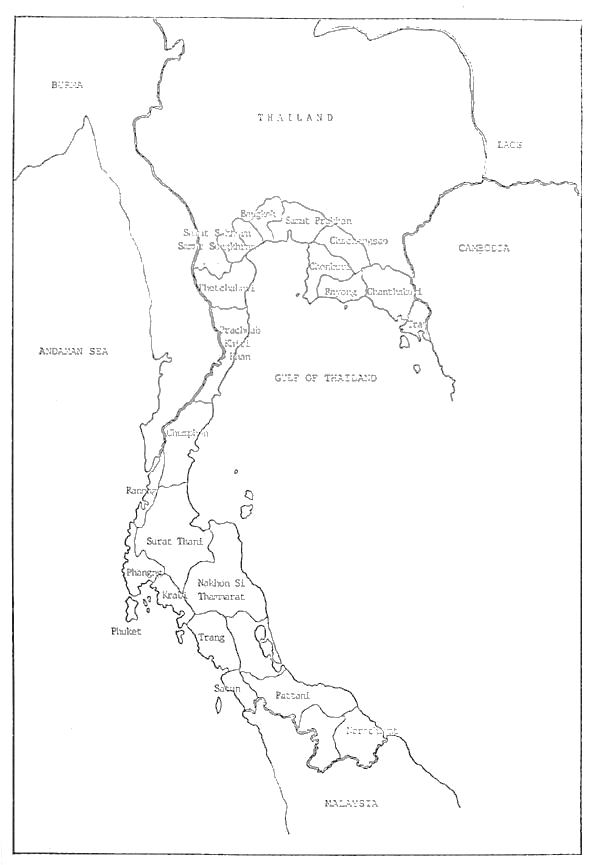
Figure 1. Map of Thailand
In 1983, there were 11 provinces where oysters were farmed; 7,046 rai were being actively cultured and a total potential area of about 35,933 rai for oyster culture was estimated (Table 2).
| Provinces | Culture Area in 1983 | Potential | Total |
| Chonburi | 1,714 | 1,000 | 2,714 |
| Rayong | 520 | 1,500 | 2,020 |
| Chantaburi | 2,922 | 3,000 | 5,922 |
| Petburi | - | 1,000 | 1,000 |
| Prachuab Khiri Khan | 21 | 2,000 | 2,021 |
| Chumpon | 538 | 940 | 1,021 |
| Surat-Thani | 494 | 1,562 | 2,056 |
| Nakorn Srithamarat | - | 1,875 | 1,875 |
| Songkhla | 1 | 550 | 551 |
| Pattani | 200 | 2,500 | 2,700 |
| Narathivas | - | 3,125 | 3,125 |
| Ranong | 625 | 3,125 | 3,750 |
| Pang Nga | 1 | 6,250 | 6,251 |
| Kra-Bi | 10 | 1,250 | 1,260 |
| Trang | - | 3,125 | 3,125 |
| Satun | - | 3,125 | 3,125 |
| Total | 7,046 | 35,933 | 42,979 |
| Percent | 16.39 | 83.61 | 100.00 |
From : Pairoj Brohmanonda, Brackishwater Fisheries Division, Department of Fisheries, information needs for effective aquacultural planning, paper for presentation on aquacultural economics workshop, at Ambassador Hotel, Bangkok, Thailand, May 6–10, 1985, Table 3.
II. Species of Commercial Importance
In Thai coastal areas, there are three dominant species, namely:
Crassostrea commercialis which is circular in shape and small. In Thailand this species is called Hoy Nang Rom Pun Lek, Hoy Park Jeep or Hoy Joa.
C. lugubris. It is mostly elongate and can grow up to 12–15 cm. Thai common names are Hoy Nang Rom Pun Yai and Hoy Takrom Kram Khaw.
C. belcheri. It has a similar shape as C. lugubris but it can be distinguished by the black internal muscle scar. It has a number of Thai common name such as Hoy Nang Rome Pun Yai and Hoy Takrom Kram Dum.
III. Distribution of important commercial species
Oysters are found abundantly in shallow water along rocky shores and intertidal mangrove areas. In Thailand, oysters are found on both the Gulf of Thailand and along the Andaman sea coasts. The species are:
C. commercialis, very abundant in the provinces of Chonburi, Chantaburi, Trat, Ranong, Prachuab Khiri Khan, Chumpon, Trang, Krabi, Rayong and Satun (Fig. 2).
C. belcheri, very abundant in Chantaburi, Chumpon, Ranong, Surat Thani, Phang Nga, Trang and Satun.
C. lugubris, very abundant in Surat Thani, Phang Nga, Songkhla and Pattani.
IV. Background of oyster culture in Thailand
Thailand has abundant oyster resources from natural beds. The
oyster beds are located in shallow coastal water of the
intertidal mangrove area. Increase in population and demand for
oyster have reduced the natural oyster populations to a level
insufficient to supply local demand. Oyster culture was started
to meet the domestic demand.
It is believed that immigrants from China first began culturing
oyster in Chonburi, Rayong and Chantaburi Provinces about 50
years ago. The culture method adopted was the use of stone on
the bottom of shallow areas. The stones served as spat
collectors and as a grow out surface for the oysters. The system
is similar to that used in the southern part of China. In the
eastern coast of Thailand oyster farming is a full-time family
occupation.
Oyster culture developed later in the southern part of Thailand.
There are 12 provinces in the east of Thailand where oyster
culture is practised (Chonburi, Rayong, Chantaburi, and Trat),
and 8 in the south (Prachuab Khiri Khan, Chumpon, Surat Thani,
Songkhla, Pattani, Narathivas, Phang Nga and Ranong) (Table 3).
Total number of farms in the east were 1,760, averaging 2.13 rai
per farm. In the south there were 496 farms with an average of
4.46 rai per farm.
From Table 3 it is evident that the largest oyster culture area
is in Chantaburi with about 1,601.97 rai (26.18%) of total area.
Chonburi, Surat Thani and Ranong have culture area of 1,443.36
(23.52), 986.04 (16.11) and 962.50 rai (15.73%), respectively.
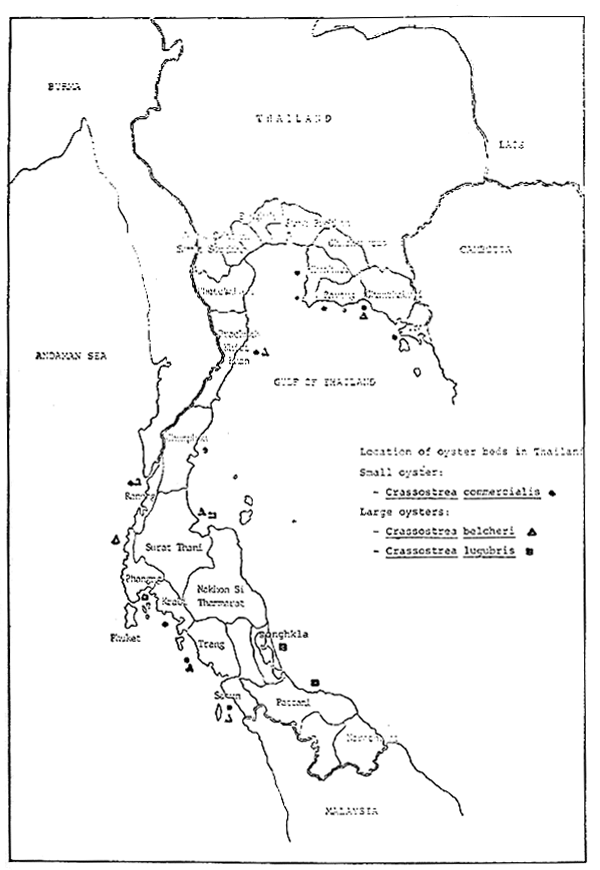
Figure 2. Location of oyster beds in Thailand.
| Province and Town | No. Farm | Area (rai) | |||
| Total | % | Rai/farm | |||
| Eastern Part | 1,760 | 3,757.06 | 61.40 | 2.13 | |
| 1. | Chonburi | 667 | 1,443.36 | 23.58 | 2.16 |
| Muang | 661 | 1,439.30 | 23.52 | 2.18 | |
| Sriracha | 6 | 4.06 | 0.06 | 0.68 | |
| 2. | Rayong | 162 | 321.40 | 5.25 | 1.98 |
| Muang | 4 | 20.62 | 0.34 | 5.16 | |
| Klaeng | 158 | 300.78 | 4.91 | 1.90 | |
| 3. | Chantaburi | 885 | 1,601.97 | 26.18 | 1.81 |
| Muang | 149 | 408,66 | 6.68 | 2.74 | |
| Tha Mai | 307 | 478.51 | 7.82 | 1.56 | |
| Khlung | 100 | 125.56 | 2.05 | 1.26 | |
| Laem Sing | 329 | 589.24 | 9.63 | 1.79 | |
| 4. | Trat | 46 | 390.33 | 6.38 | 8.48 |
| Khao Saming | 46 | 390.33 | 6.38 | 8.48 | |
| Southern part | 496 | 2,362.12 | 38.60 | 4.76 | |
| 5. | Prachuab Khiri Khan | 85 | 52.84 | 0.86 | 0.62 |
| Muang | 27 | 15.42 | 0.24 | 0.57 | |
| Hua Hin | 10 | 1.00 | 0.01 | 0.10 | |
| Pran Buri | 5 | 22.16 | 0.35 | 4.43 | |
| Bang Saphan Noi | 43 | 14.26 | 0.26 | 0.33 | |
| 6. | Chumpon | 19 | 351.44 | 5.74 | 18.49 |
| Muang | 6 | 3.44 | 0.06 | 0.57 | |
| Sawi | 13 | 348.00 | 5.68 | 26.76 | |
| 7. | Surat Thani | 225 | 986.04 | 16.11 | 4.38 |
| Muang | 7 | 56.00 | 0.92 | 8.00 | |
| Chaiya | 25 | 140.50 | 2.29 | 5.62 | |
| Kanchanadit | 193 | 789.54 | 12.90 | 4.09 | |
| 8. | Songkhal | 3 | 0.72 | 0.01 | 0.24 |
| Chana | 3 | 0.72 | 0.01 | 0.24 | |
| 9. | Pattani | 110 | 4.46 | 0.07 | 0.04 |
| Panare | 110 | 4.46 | 0.07 | 0.04 | |
| 10 | Narativas | 46 | 3.82 | 0.06 | 0.08 |
| Muang | 46 | 3.82 | 0.06 | 0.08 | |
| 11 | Phang Nga | 6 | 0.29 | - | 0.04 |
| Muang | 1 | 0.09 | - | 0.09 | |
| Thap Put | 2 | 0.08 | - | 0.04 | |
| Takua Thung | 3 | 0.12 | - | 0.04 | |
| 12 | Ranong | 2 | 962.50 | 15.73 | 481.25 |
| Muang | 2 | 962.50 | 15.73 | 481.25 | |
| Total | 2,256 | 6,119.18 | 100.00 | 2.71 | |
From: Fisheries Statistics Section, Fisheries Economics and Planning Sub-Division, List of Oysters Farmers and their raising area by Location Computer printed out, 1984.
V. Selection criteria for oyster culture sites
Physical parameters are the most crucial factors in selecting suitable culture areas. A good area should have the following characteristics:
It should have shallow water and be located in a mud flat or soil with sandy loam composition. The mud layer should be thin or should be located over a hard bottom to support the substrate for culture depending on the method of culture. The coastal region of Thailand has many sites that meet this criteria.
Natural seed supply should be present or found in a nearby area to ensure that the area can be cultured and to maintain low production costs.
There should be no influx of freshwater that would reduce the salinity for long period during the rainy season.
Currents and strong winds should not be too strong in order to efficiently manage the culture substrate. A suitable area would be an enclosed bay or protected shoreline.
Optimum current in the area would be 3–5 m/min. The water should be rich in nutrients for plankton growth and should be moderately clear with low turbidity and good light penetration.
There should be no external source of pollution that can release substances harmful to the oysters or to humans. The area should be located away from mining activities that tend to reduce water transparency. Turbidity reduces oyster growth rate and can cause considerable spat mortality.
Substrate material should be available at low cost in the local area. For example, rock, bamboo, empty shell and other materials depending on the availability.
The area should have few or no oyster predators such as starfish.
The culture site should be located near a market or an area with a developed infrastructures such as roads.
The site should have full strength sea water. During the rainy season, oyster can be temporarily transferred to waters of higher salinity.
VI. Oyster Culture Sites in Thailand
There are many environmental factors that affect oyster culture in Thailand related to the suitability of the culture site. Factors of major concern are:
Bottom: The bottom serves as a base to hold the substrate to
which oyster attach, or to hold anchor in raft and long line
culture.
In Thailand, most oyster culture sites extend up to 3 km from the
shore. There are 2 kinds of bottoms:
Muddy bottom. This kind of substrate is found in the Gulf of Thailand and in the provinces of Chantaburi, Prachuab Khiri Khan, Chumpon and Surat Thani except Trat, Rayong and Chonburi.
Sandy Clay loam bottom. This substrate is typical of the Andaman coast and in some provinces facing the Gulf of Thailand such as Ranong, Satul, Songkhla, Chonburi and Rayong.
Wind: Wind is another factor that can produce harmful effects on the substrate. There are two monsoons in Thailand that can affect oyster farms.
Northeast monsoon affects oyster farms in the Gulf of Thailand, and the.
Southwest monsoon which affects oyster culture in the Andaman Sea.
Salinity: The salinity of the Thai Gulf sea water is normally lower than the salinity of the Andaman Sea. In the Gulf of Thailand salinity values vary between 10–30 ppt due to numerous rivers flowing into this gulf such as the Wain River in Chantaburi, Tapi River in Surat Thani and other small rivers and canals; values varying between 29–33 ppt are typical of the Andaman Sea.
Tide Levels: The culture grounds in Thailand have varying tidal levels:
The east coast provinces which consist of Chonburi,
Rayong, Chantaburi and Trat, have a tidal average quite
different between highest tide to lowest tide (Table
4).
The highest seawater in Chonburi is 40 decimeters and
the lowest sea water is 5 decimeters. The difference
is 35 decimeters or 3.5 m.
In southern Thailand there is a narrower range of tide interval. The lowest seawater at zero level, is at Pattani. In Songkhla, tidal interval is only 6–7 dm.
The tidal characteristics in southern Andaman Sea is similar to eastern Thailand. In Ranong the highest seawater is 42 decimeters (4.2 m), the lowest 6 dm.
| PROVINCE | JAN | FEB | MAR | API | MAY | JUN | JUL | AUG | SEP | OCT | NOV | DEC |
| CHONBURI | 11–41 | 9–41 | 7–38 | 6–34 | 5–36 | 5–38 | 5–40 | 8–40 | 9–37 | 10–37 | 13–39 | 18–40 |
| RAYONG | 8–34 | 7–38 | 6–29 | 4–27 | 2–26 | 1–27 | 1–27 | 3–27 | 5–28 | 9–32 | 13–34 | 10–34 |
| CHANTHABURI | 7–24 | 7–25 | 6–24 | 6–24 | 6–23 | 6–23 | 5–24 | 5–25 | 6–25 | 8–26 | 11–25 | 8–24 |
| TRAT | 9–29 | 10–27 | 10–25 | 11–24 | 11–25 | 10–25 | 9–26 | 9–27 | 10–26 | 11–29 | 14–30 | 14–30 |
| PRACHUB KHIRI KHAN | 4–30 | 4–27 | 2–28 | 1–27 | 1–25 | 2–29 | 3–29 | 4–28 | 4–27 | 6–29 | 8–29 | 8–29 |
| CHUMTON | 5–21 | 4–18 | 4–17 | 2–16 | 0–14 | 0–12 | 0–14 | 1–14 | 2–16 | 3–20 | 6–22 | 6–22 |
| SURAT-THANI | 2–23 | 3–21 | 3–20 | 3–21 | 2–20 | 1–18 | 1–21 | 2–22 | 3–24 | 4–24 | 5–24 | 5–23 |
| SONGKHLA | 5–13 | 5–12 | 6–12 | 6–12 | 5–12 | 6–12 | 6–12 | 5–12 | 6–12 | 6–13 | 6–13 | 6–13 |
| PATTANI | 4–11 | 3–11 | 3–10 | 2–9 | 1–9 | 1–9 | 0–9 | 0–8 | 1–8 | 2–9 | 3–9 | 4–11 |
| NARATIWAT | 2–10 | 2–11 | 2–11 | 2–10 | 2–11 | 2–11 | 2–12 | 1–12 | 2–11 | 1–10 | 1–8 | 1–9 |
| SATUN | 5–33 | 5–34 | 5–35 | 7–36 | 7–36 | 7–37 | 5–38 | 5–37 | 6–35 | 7–33 | 7–33 | 6–38 |
| RAHONG | 7–39 | 7–40 | 8–42 | 9–42 | 9–42 | 7–42 | 6–43 | 6–42 | 6–41 | 8–39 | 8–39 | 9–38 |
| From: Hydrographic Department Royal Thai Havy 1988. | ||||||||||||
All the figures shown in Table 4 were recorded between 6 am and 6 pm. The tidal fluctuation plays a big role in oyster culture particularly on spat collection, harvesting period, etc.
pH: pH in seawater is normally about 8. According to the Marine Fisheries Division, the pH at the shore is 8.10, while it is 8.30 off shore.
VII. Culture Method
There are various methods used to culture oysters. Each method is biologically suitable at specific locations. The different methods are used depending on site factors. In Thailand the common culture methods are the following:
1. Rock culture method
Rocks are used as substrate for oyster spat settlement. the
oysters remain on the rock until harvested. The area should be
close to a supply of natural rocks. Rocks are piled in group of
5–10 and spaced in rows approximately 50 cm apart each way (Fig.
3). The bottom should be firm and smooth. For areas with soft
bottom mud, a platform or mat or bamboo can be used to prevent
the rocks from sinking such as in Amphoe Sawee in Chumpon
Province. Rocks are placed on 1×2 m bamboo platform; each pile
of rock is about 0.83 m apart while each row is roughly 1.16 m
apart. One set consists of three layers.
In Chonburi the rock method is modified with the use of concrete
poles because rocks are not easily available. In this method
four concrete poles are sunk into the bottom while another two
are laid parallel on top of them. Three more poles are placed
horizontally above the upper two poles. A pile of stones is then
laid on top of the concrete floor (Fig. 4). A distance of 1.33 m
is maintained between each set and each row (Table 5).
2. Culture on cement pole
This method is widely used in Surat Thani, Rayong and Chantaburi. Principal material is a 12–16 cm diameter and 35 cm long cement pole with a central cavity at the lower end for insertion on a bamboo or wooden pole. The cement cap is then placed over the bamboo pole. Poles are about 0.5 m in distance, and each row 2.15 m apart (Plate 1).
3. Bamboo stick culture method
One- to two-meter long bamboo sticks are driven 30–50 cm into the substrate (Plate 2) 15–42 cm apart. Rows are about 2–3 m apart.
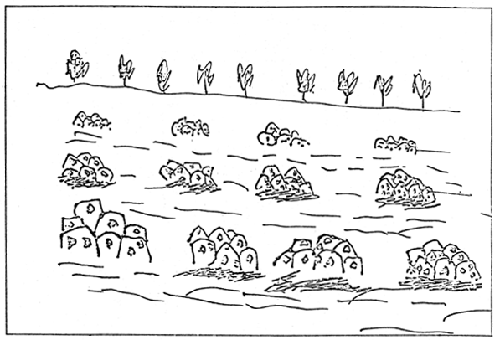
Figure 3. Rock culture method.
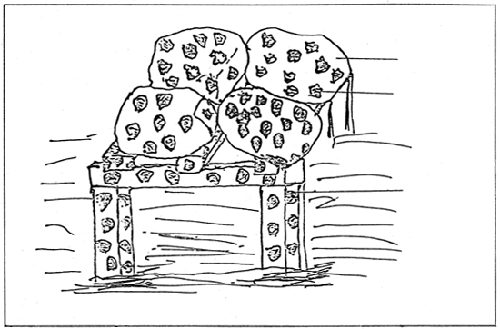
Figure 4. Oyster rock and concrete pole culture method.
| Method | Bottom | Distance between materials (m) | ||||||||||
| Muddy | Sandy Clay loam | Rock | Rock & Concrete pole | Cement pole | Bamboo | Cement pipe | ||||||
| Stake | Row | Set | Row | Pole | Row | Stick | Row | Pipe | Row | |||
| 1. Rock | x | 0.5–0.83 | 1.16 | |||||||||
| 2. Rock concret pole | x | x | 1.33 | 1.33 | ||||||||
| 3. Cement Pole | x | x | 0.5–1.5 | 1.–2.15 | ||||||||
| 4. Bamboo stick | x | x | 0.15–0.46 | 0.46–3.00 | ||||||||
| 5. Cement pipe | x | 0.83 | 1.96 | |||||||||
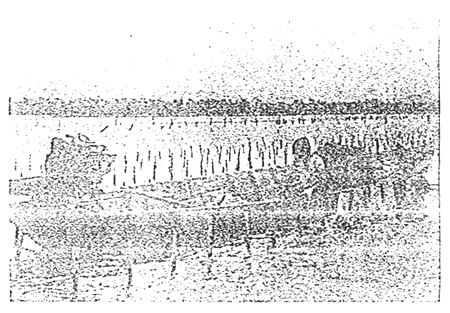
Plate 1. Oyster cement pole culture method.
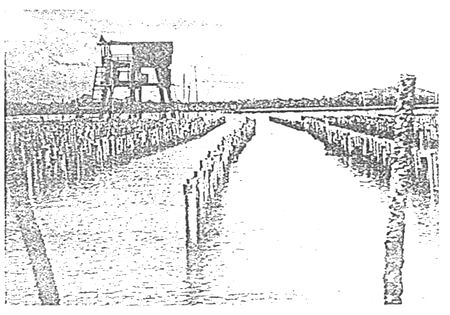
Plate 2. Oyster bamboo culture method.
In Amphoe Bang Saphan, Prachuab Khiri Khan bamboo sticks are used to culture spat to marketable size. However in Surat Thani this method is used exclusively for spat collection while grow-out is by cement pole or the hanging method.
4. Cement pipe culture method
Some farmers believe that oyster spats prefer to settle on cement pipes rather than other substrates. Cement pipes offer a larger surface area for oysters to settle and grow. The pipes are 40–50 cm in diameter and 20–45 cm high. They are rested on 3 bamboo poles stacked in the bottom (Plate 3). The cement pipes are kept 10–15 cm above the bottom. Each set of pipes is 65 cm away from each other and each row 1.5–1.6 m apart.
5. Tray culture method
Tray culture method is commonly used in muddy bottom areas near
the mouth of rivers where the water remains brackish all year
round. Trays can be built in any convenient size, however a
popular size is 80 × 100 cm with an upright side of 25 cm in
height. The trays are often constructed from strong wood
although bamboo can be used.
The tray is mounted and staked approximately 30 cm above the
bottom (Fig. 5).
In Surat Thani the trays are used for stocking oyster in the farm
before they are sold.
Pairoj (1986) reported that small oysters 6–7 months in age and
3.5–4.5 cm in length are removed from rocks and placed in the
tray. It takes about 12 months to grow these oysters to
marketable size.
Large oysters are placed in trays at about 3–4 months of age and
3–4 cm in length. The grow-out period for 7–8 month-old oysters
is about 4 months prior attaining market size.
6. Hanging culture method
The hanging method is suitable for ongrowing large numbers of
oysters. Plate 4 illustrates the method. Oyster shells (left
shell) are attached with cement and a rope is passed through the
centre of the shell to string the cultch together.
This method makes it easy to take care and harvest the oysters.
7. Other culture methods
In addition to the types of culture materials listed above, others include car tires, asbestos roof tiles, broken earthen pots, etc.
VIII. Spat collection
Oyster spats in Thailand are mostly collected from the wild or lured from the natural ground. Although spats can be produced from the hatchery in Prachuab Brackishwater Fisheries Station, production costs are. Spat collection methods differ according to species and location.
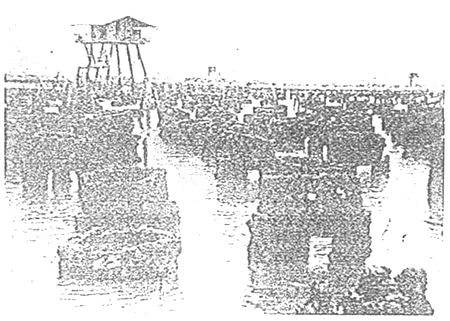
Plate 3. Oyster cement pipe culture method.
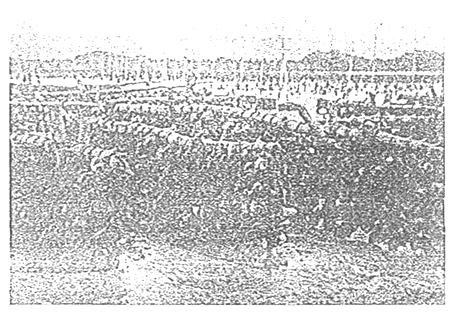
Plate 4. Oyster hanging culture method.

Figure 5. Oyster tray culture method.
Somkit (1987) reported the following observations:
In the eastern part of Thailand oyster farmers set the luring materials on 2 periods of the year:
April to June in Chonburi and Rayong, and
August to November in Rayong and Chantaburi (Fig. 6).
Two spatfall seasons can be detected in the east coast of Thailand: October - December and June - August (Fig. 8).
In Southern Thailand, the setting of luring material and spatfall depend on the season in each province.
In Prachuab Khiri Khan spat collectors are placed in the sea in November - January (Fig. 8) as the spatfall season occurs between November - March (Fig. 10). Timing is different in Chumpon and Surat Thani provinces (Fig. 7 and Fig. 9).
IX. Harvesting
C. commercialis are harvested by using hammers and sharp steel
rods to pry them off the substrate. The harvesting periods vary
from province to province.
In Chonburi there are two harvesting periods, from January to
April and from November to December.
Chantaburi, Prachuab Khiri Khan, Chumpon and Rayong harvest on
April-August, April-October, June-September and October-December,
respectively. (Fig. 10).
The large species, C. lugubris and C. belcheri are removed from
the substrate after culture for 18–24 months usually with a small
ax. The harvest is stocked in the farm or sold immediately.
Harvesting of large oysters is done almost the whole year round
except in November-January because it is the monsoon season (Fig.
15).
X. Marketing and Handling
Oysters are mainly sold in the domestic market. The small
species mostly pass from the collectors or middlemen, to the
wholesalers, retailers and on to the consumers.
Marketing is controlled mostly by Chonburi middlemen. The
middlemen and collectors from Chonburi collect oyster in
Chantaburi, Prachuab Khiri Khan and Chumpon at different months
from Chonburi, except in Rayong where harvesting is done all year
round.
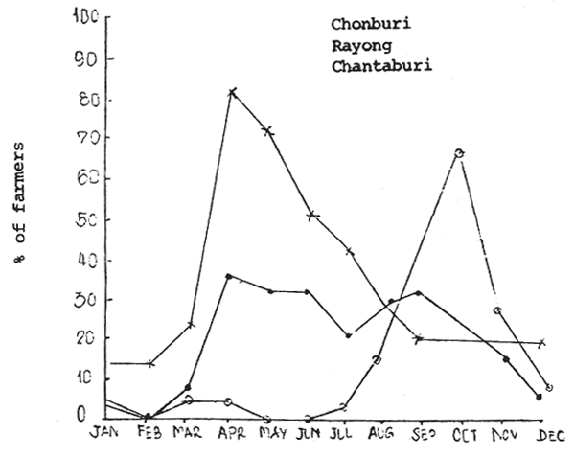
Figure 6. Percentage of farmers luring spat in
the East part of Thailand.
(From: Survey, Somkit, 1987).

Figure 7. Percentage of farmers luring oyster
spat in the South of Thailand.
(From: Survey, Somkit, 1987).
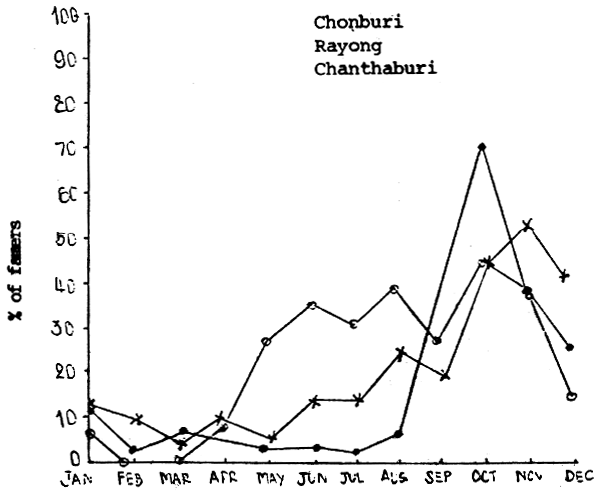
Figure 8. Spatfall season in the Eastern part of Thailand (1985).
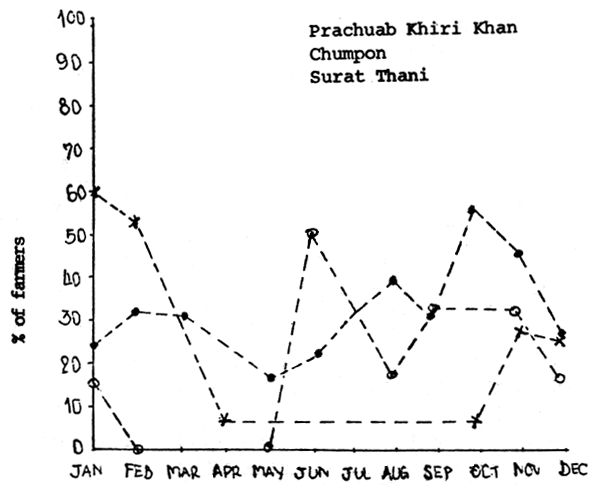
Figure 9. Spatfall season in the Southern part of Thailand (1985).

Figure 10. Harvesting period of the small oyster
Crassostrea commercialis (1985).
(From: Somkit Tugsinavisuiti, 1987).
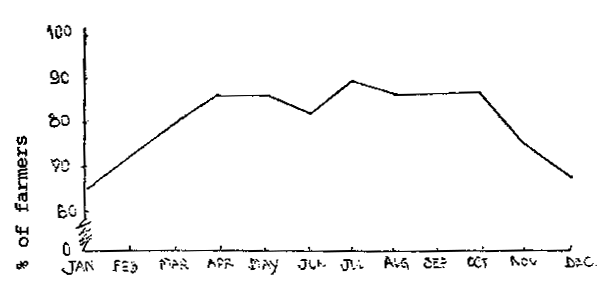
Figure 11. Harvesting period of the large oyster,
Crassostrea belcheri in Surat Thani (1985).
(From: Somkit Tugsinavisuiti, 1987).
XI. Handling of small oyster
The wholesaler removes the shell before sending the product to
the retailer or restaurant. Shucked oysters are preferable
mainly because it is difficult to open the small sized oyster.
With regard to the large species of oyster, the market price is
good all year due to high demand. During the monsoon season, the
price increases particularly in November - January. Thus the
farmer usually tends to stock oyster near the guard house during
these periods.
In handling the large species of oysters (C. belcheri and C.
lugubris) the farmer will stock them in the farm near the guard
house, or sell them immediately after harvesting. Consumers
prefer to eat these species raw, with lemon, chili, garlic, salt
and epilleaf. Oysters are transported in jute sac, which allows
them to survive for 24–48 hours as long as they are not exposed
to direct sunlight or hot air. The farm gate price of this
species is about 5–6 Baht for medium size (10–11 cm in length)
and 7–7.5 Baht for large size (11–13 cm in length).
XII. Constraints
Rabanal et al. (1977) reported that water pollution has caused oyster mortality in Thailand. Poaching and sedimentation are also believed to be major constraints to oyster culture in Surat Thani.
There are four main constraints to oyster culture in Thailand:
Water pollution. Most oyster farmers are facing this problem. In 1985 high mortalities of oyster in Chantaburi and Rayong were reported and related to environmental pollution.
Sedimentation. Culture areas are becoming shallower every year. In Surat Thani the oyster farmers are moving to deeper areas due to sedimentation in the old sites.
Lack of natural seed. Farmers in Chonburi, Prachuab Khiri Khan and Surat Thani complain that seeds are becoming less every year.
Poaching. It is a serious problem in Surat Thani.
XIII. References
Amartayakul, C. (1959). Shellfish of Thailand. Thai Fisheries Gazette. Department of Fisheries, Ministry of Agriculture and Cooperatives. Vol. 12. No. 4, p. 345–354.
Brohmanonda, P. (1962). Spawning Season of Small Oyster. Thai Fisheries Gazette. Department of Fisheries, Ministry of Agriculture and Cooperatives. Vol. 5, No. 3, p. 283–305.
Brohmanonda, P. (1967). Spawning Season and Abundance of Oyster at Leam Tan, Chonburi Province. Thai Fisheries Gazette. Department of Fisheries, Ministry of Agriculture and Cooperatives. Vol. 20, No. 1, p. 116–0132.
Brohmanonda, P. (1971–1972). Some Biological Aspects of Oyster at Klong Na tap Songkhla Province. Annual Report of Songkhla Marine Fisheries Station, Department of Fisheries, Ministry of Agriculture and Cooperatives 1971–1972, p. 107– 129.
Brohmanonda, P. et al. (1986). Oyster Culture in Thailand. Paper preparation for presentation at Marine Biological Centre, Phuket, Thailand. 27 pp.
Rabanal, H. R., Pongsuwana, U., Saraya, A. and W. Poocharean (1977). Shell Fisheries of Thailand: Background and Proposal for Development, SCS/77/WP/61 South China Sea Fisheries Development and Coordination Programme, Manila, Philippines 48 pp.
Tugsinavisuitti, S. (1987). An Economic Analysis of Oyster (Crassostrea sp. Farming in Thailand Asian Fisheries Social Science Research Network, Thailand. Department of Agricultural Economics. Faculty of Economics and Business Administration, Kasetsart University, Bangkhen, Bangkok, Thailand. 109 pp.